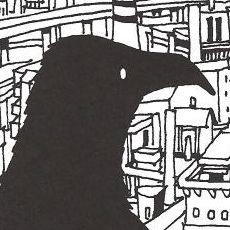Author: bateszi
-
Pale Cocoon: Apathetic sci-fi short
/
/ ReviewsRead More →: Pale Cocoon: Apathetic sci-fi shortDescribed in some parts as a spiritual follow-up to the much lauded sci-fi short Voices of a Distant Star, Yasuhiro Yoshiura’s Pale Cocoon is another 22 minute OVA that attempts to express a wistful charm by means of an isolated space setting. The story is that (for some undefined reason) mankind has migrated to the…
-
Studio 4C's Comedy – Medieval fable set in Ireland
/
/ ReviewsRead More →: Studio 4C's Comedy – Medieval fable set in IrelandStory so far Set during Ireland’s War of Independence, a young Irish lass, besieged by the merciless English soldiers, seeks the help of a legendary swordsman who is rumoured to have supernatural powers. My impressions Studio 4C’s Comedy is a gripping 10 minute OAV from Kazuto Nakazawa; the main creative force behind Kill Bill’s ultra-violent…
-
Kiba – 1 through 3 – Cliche shounen strikes again
/
/ ReviewsRead More →: Kiba – 1 through 3 – Cliche shounen strikes againStating my desire for yet more shounen escapades, today I took in the first three episodes of Kiba. Mediocre is the word that immediately comes to mind; neither bad nor outstanding, Kiba is a by the books fantasy adventure story packing just enough intrigue to maintain my interest from episode to episode. Disappointingly (especially considering…
-
Ergo Proxy – 5 – Revolution is in the air
/
/ ReviewsRead More →: Ergo Proxy – 5 – Revolution is in the airWe’ve had to sit through five episodes, but it’s only now starting to feel like Ergo Proxy is settling down into a proper flow of story-telling and I’m enjoying it a lot more; on a level beyond what previously amounted to a purely superficial attraction. I suspect I preferred this episode to it’s predecessors because…
-
Early impressions of Ergo Proxy
/
/ ReviewsRead More →: Early impressions of Ergo ProxyAs a means of grasping the story of Ergo Proxy, I decided to hold off on watching the first four episodes and marathoned my way through them earlier today; in terms of understanding the plot, I can’t say this approach ended up benefiting me. Ergo Proxy has a very fractured narrative flow, there are no…
-
Yokohama Shopping Trip – 2
/
/ ReviewsRead More →: Yokohama Shopping Trip – 2Despite clearly being the better of the original two Yokohama Shopping Trip OVAs, episode two serves up an unsettling mood of desolation and loneliness. During a five minute period in which Alpha simply brews a cup of coffee, there is no music, no dialogue, only the sounds of a creeky old house to keep her…
-
Yokohama Shopping Trip – 1
/
/ ReviewsRead More →: Yokohama Shopping Trip – 1My fascination with the weird, coupled with an obtuse interest in searching out the obscure has led me down the path of downloading the kind of anime people forgot about many moons ago- and so here I am to introduce you to Yokohama Kaidashi Kikou; talked up a wandering traveller anime in the spirit of…
-
Mushishi – 20
/
/ ReviewsRead More →: Mushishi – 20Looking back on Mushishi, I suspect that this episode (episode 20) will rank as one of my favourites. Every episode has had that unique air of mystisism; a beautiful sense of magic that I have come to love, but still, rarely have a felt so attached to the characters as I did in this episode.…
-
Mushishi – 19
/
/ ReviewsRead More →: Mushishi – 19Despite displaying none of the euphoric highs and gut wrenching lows of previous episodes, Mushishi 19 was an uplifting way to while away 23 minutes. The concept here is really quite profound- consider that without someone to love you, you disappear. Fuki, the lead character of this story, gets “infected” by a Mushi that will…
-
One Piece – My Love Lorn Introduction
/
/ ReviewsRead More →: One Piece – My Love Lorn IntroductionWhen it comes to swash-buckling Shounen Jump fun, the winky smiley face of One Piece stands proud. It took me a while to catch onto this show- I only started watching in January 2006, but spurred on by what has to be the most unique character designs I’ve come across in a mainstream anime series,…
